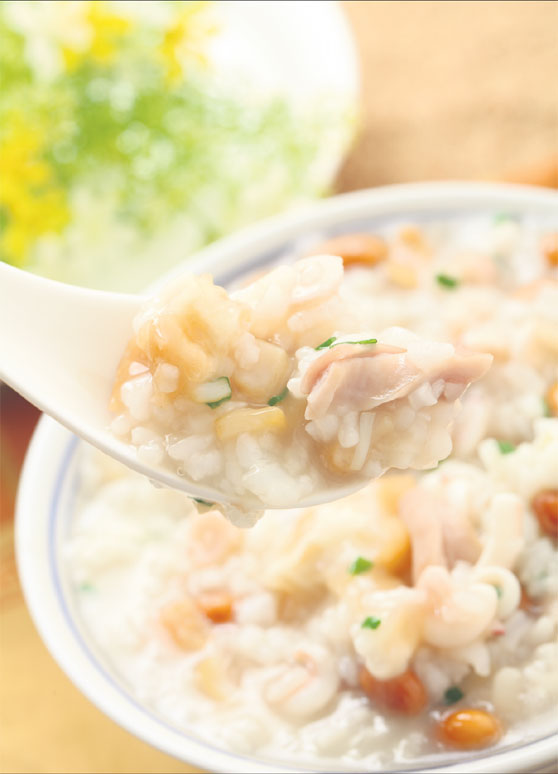Glorious porridge
Editor's Note: Traditional and fusion cooking styles, regional and international ingredients and a new awareness of healthy eating are all factors contributing to an exciting time for Chinese cuisine. We explore the possibilities.
My father's family comes from Shunde, Guangdong province. It is a land of milk and honey, full of pleasures and treasures from mountain and sea.
If the best chefs from China come from Guangdong, then the finest chefs from Guangdong are from Shunde. Food is everything to the Shunde native, and the appreciation of good food is deeply ingrained in genetic memory.
At the heart of this culinary heritage is just one word - fresh.
|
Rice porridge can be served at breakfast or dinner, depending on how luxurious they are. Provided to China Daily |
Ingredients, from meat to vegetables, must be absolutely fresh. That often means food must still be alive minutes before it is tossed into the frying pan.
All five meals are important, but breakfast is especially significant, with a wide assortment of noodles, rice rolls, dumplings ... and rice congee.
Shunde porridge must be carefully and slowly brewed from specially prepared rice. It is a smooth and silky congee, boiled down so every grain blooms and melts and fuses into one hot, steaming bowl.
The culture of the rice gruel is almost a separate cuisine by itself, and it features a range from the very simple to the absolutely decadent. The most basic is a plain rice porridge, seasoned with a drop of oil and a pinch of salt and served at breakfast to wake the palate and prepare it for more complicated flavors later in the day.
Its accompaniment may be a simple stick of youtiao, the deep-fried dough fritter, or more often than not, a combination of dough fritter wrapped in a rice roll, known as zhaliang. The crisp fritter, the silky rice roll and the velvety porridge make for the perfect combination to start the day.
Another popular breakfast variation was black pudding porridge, with pig's blood added to the white congee.
Porridge is served not just at breakfast. It is eaten just as often for lunch, dinner or supper.
On the other end of the spectrum are the luxurious seafood porridges flavored with lobster, sea cucumber and precious abalone. These would be seasoned with dried sea whelks and dried scallops, with the porridge forming a crucial backdrop.
In old Guangzhou, there was an area known as Lychee Bay that was famous for its sampan porridge, tingzhaizhou. It started out as poor man's fare, and was cobbled together from what couldn't be sold from the catch of the day.
The enterprising fisher wife marinated fish slices, little squids and baby prawns and tossed them into rice porridge, garnishing the bowl with fried peanuts and crispy, deep-fried vermicelli crackers.
They would row their little boats, or sampans, close to shore and sell their porridge to late-shift workers or revelers from the nearby red light district. This simple bowl of porridge was so popular that it became associated with the area, and now Lychee Bay sampan porridge is well-known in Chinese communities worldwide.
Another Cantonese classic is pork porridge, a hearty bowl featuring almost every part of the pig but the oink.
Pork bones are simmered to get a rich stock in which to cook the porridge. The meat is minced with pickled vegetables to form tiny meatballs that are cooked almost instantaneously when added to the hot gruel. Carefully cleansed and marinated slivers of kidney and liver, big and small intestines, thinly sliced fillets and sometimes even chunks of brain are all added.
Every bowl of porridge is individually cooked. The various bits and bobs are placed at the bottom of the bowl, and the scaldingly hot rice porridge is poured onto them.
Mothers would feed their children this before an important test or examination, because it was known as the "scholar's porridge".
According to culinary legend, the famous Cantonese Ming Dynasty (1368-1644) scholar and wit Lun Wenxu ate this regularly before he sat for his imperial examinations, and when he topped the list, this porridge became even more popular.
Maybe it was the chunks of brain in the porridge that did the trick.
These day, the pork porridge is served with less exotic additions, with only meatballs, sliced pork, kidney, liver and small intestines. It is still a savory treat, especially with a raw egg broken into the bowl.
The other ingredient very often used in Cantonese porridge is fish. Shunde is known for its fish ponds lined with mulberry trees, and the crucian carps raised in these waters are sweet and crisp.
The fish is filleted and sliced paper-thin. The skin is attached for better texture, and scalding hot porridge is poured into the bowl to cook the fish. Fried pickled vegetables, youtiao croutons and shredded fresh lettuce are added as garnishes.
In addition, pieces of the gelatinous fish head are sometimes cooked in the porridge for yet another satisfying dish.
Shunde chefs are always innovative, and in recent year, they have added yet another new way to eat porridge - as the base of a seafood hotpot. Everything from lobsters, abalone, sea cucumber, salmon, oysters and clams is placed in there to cook, and after the delicacies are done with, the porridge is portioned out and enjoyed for its essence of seafood.
Rice porridge - will you ever look at it the same way again?
paulined@chinadaily.com.cn
Recipe
Scholar's porridge
(Serves four)
2 cups rice
8 cups pork stock
1 kg pork bones
2 slices ginger
200 g fatty pork mince
1 tablespoon Tianjin pickled vegetables, dongcai
1 tablespoon cornstarch
Salt and pepper
200 g pork liver
1 set of kidneys
200 g pork loin, thinly sliced
Cornstarch, salt, ginger juice, Chinese wine
First, soak the rice in plenty of water, with a tablespoon of oil added. Leave for at least six hours, or overnight.
Prepare the stock by first blanching the bones. Rinse them clean of scum and place in a large pot with the ginger slices and 10 cups of water. Bring to a boil, and then reduce to a simmer for an hour.
Clean the kidneys, removing any white membranes and lighter-colored sections. Scour the surface in a diamond pattern and cut into slices.
Remove any veins from the liver and cut in diagonal slices. Marinate with cornstarch, salt and pepper and a little Chinese wine and ginger juice.
Slice the pork into thin slices and marinate with cornstarch, salt and pepper.
Make the meatballs by mixing the minced meat with the chopped pickled vegetables and season with salt and pepper and a little cornstarch. Mix well in one direction and set aside.
Wash the rice, rubbing the grains gently between your palms. Rinse and drain.
Bring the 8 cups of pork stock to a boil and add the rice grains. Bring it back to a boil again, then cook on medium heat till the grains blossom. Turn down the heat to a hard simmer and cook till the porridge thickens and is smooth. Ideally, you should not see any rice grains at all.
Shape little meatballs by the spoonful and drop into the porridge. You can add the sliced pork fillets now as well.
Just before serving, bring the whole pot to a bubbling boil. Tip the kidney and liver slices in, count to three and switch off the heat.
Serve immediately. Season individually with more salt and pepper and sesame oil. You may want to cut up some youtiao as croutons to serve with the porridge.
(China Daily European Weekly 10/05/2018 page18)



















